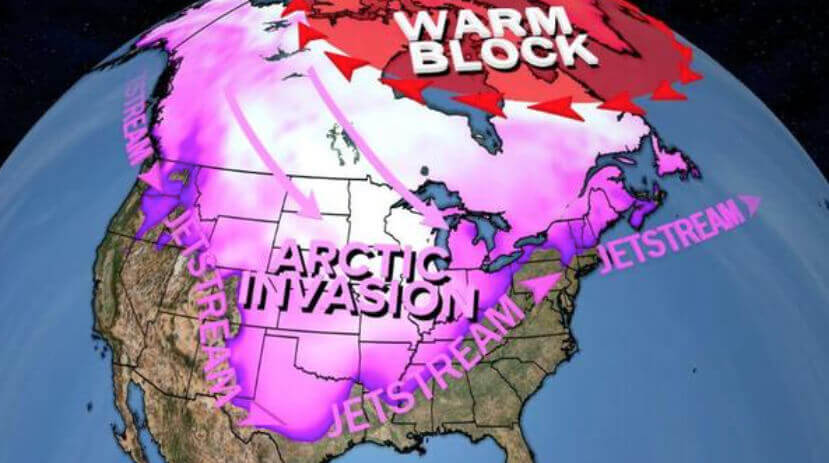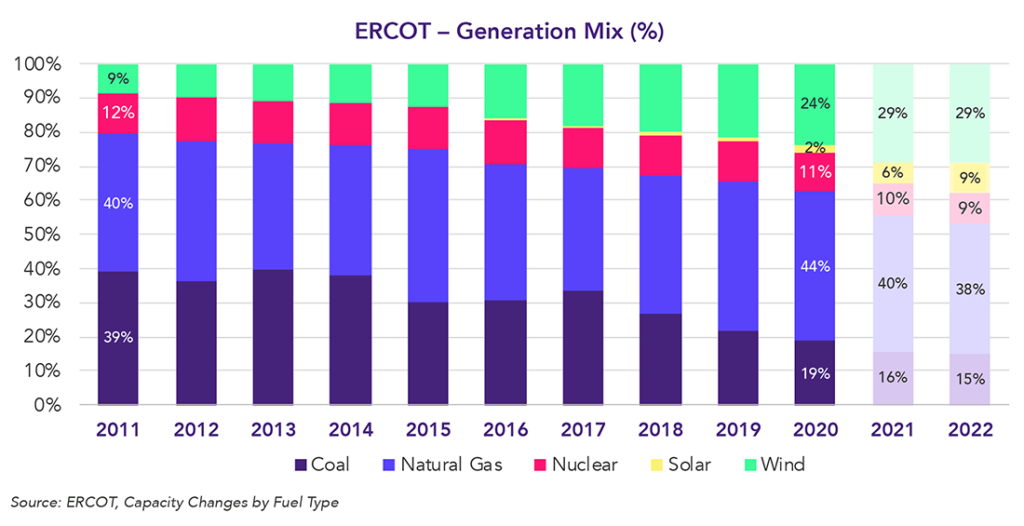What’s going on with Texas (ERCOT) electricity? And more importantly, why don’t I have lights?
Below we walk through what’s going on with Texas electricity during this brutal cold snap. We also have some ideas on why rolling blackouts have turned to 36+ hours without power in some areas.
Why is it Cold Right Now in Texas?
The Polar Vortex, last seen in the US in January 2019, is making a visit to Texas.
The Polar Vortex is a mass of cold air that spins above the Arctic. If that air is disturbed by warming or cooling spurts, some of the air can move down into North America.

Right now, the central US is experiencing record low temperatures. Everything from Chicago to South Texas is impacted. Temperatures in Texas are 30-40 degrees lower than normal for this time of year.
And that’s important because it’s impacted the price and availability of fuel across the country, including oil and natural gas. Natural gas is being consumed at record levels, for heating. And that’s impacting natural gas power plants in Texas.
Why is the Cold Causing Electricity Outages in Texas?
Many are blaming the current lack of electricity on renewables. After all, Texas is one of the leaders in renewable energy. In 2021, ERCOT expects 29% of power to come from wind, and 6% to come from solar.
And yes, when the wind doesn’t blow and the sun doesn’t shine, these power sources don’t operate. There are also issues with turbines in west Texas freezing up and becoming inoperable. But renewable energy issues account for around 25-30% of the lack of power supply.

The current issue lies more with traditional energy resources.
Texas power plants do not have advanced winterization. That means mechanical failures occur during freezing temperatures.
Mechanical failures also impact oil production. Almost half of US natural gas is a by-product of oil production. So that has also impacted natural gas availability…just as gas demand has surged for heating.
As temperatures have dropped, natural gas pipelines have started to freeze and gas is moving slower than normal. The level of gas being consumed to heat homes means lower pressure in the pipes. That also makes it more difficult to bring natural gas power plants back online.
Natural gas supplies are constrained across the country due to the cold.
So much so that on February 12th, Texas regulators at the Railroad Commission of Texas met to prioritize natural gas resources for Texas. The number one priority? Delivery of gas to residences, hospitals, churches and other human needs customers, along with delivery to local natural gas distribution companies like Centerpoint and Atmos Energy.
In second place? Delivery of gas to electric generation facilities. (You can read the RCC Emergency Order here.)
But that’s only part of the problem.
Why Are the Lights Off in Texas Right Now?
ERCOT is the traffic cop that manages power for 90% of the state. They work on the supply and demand of power, balancing load (demand) with generation (supply).
If demand outstrips the supply, there can be catastrophic failure of the power grid. You can see an example of that in the northeast blackout in 2003.
On Sunday night, ERCOT watched tremendous demand growth due to the cold. At the same time, “multiple generating units began tripping off-line in rapid progression due to the severe cold weather,” according to Dan Woodfin, senior director of system operations at ERCOT, the organization that manages the state’s electric grid.
As ERCOT representatives stated on a February 16 media call, “If we’d let that stay imbalanced it would have been catastrophic for the entire grid.”
Picture 29 million people in Texas without power, instead of 4.2 million Texans.
That night, ERCOT made the decision to immediately call for a 10,000 MW reduction in power usage. Each transmission and distribution provider in Texas received a request for immediate power reduction. ERCOT initiated outages early Monday morning around 1:30am.
And that’s where we are now.
Things may get worse before they get better. On Monday, 34,000 megawatts were offline. As of Tuesday 45,000 MW of power is offline. Of that, 15,000 of downed power production is from wind and 30,000 is from gas and coal-fired plants. During normal operating conditions, the grid has 82,000 MW of generation capacity.
Why Are the Rolling Blackouts not Rolling?
So all of that tells you a little bit about power, and the issues of supply and demand. The bigger question for most people is, why are the rolling blackouts not rolling?
Transmission and distribution companies (Centerpoint, Oncor, TNMP, AEP-Central, AEP-North) are the companies that must decide where to turn the power off and where to leave it on.
They focus on keeping power on for critical resources. That includes things like hospitals, government buildings and registered critical care customers who have a medical necessity for power.
Normally rolling blackouts means rotating power resources among different areas of the grid. But instead, if your lights went out, they have stayed out.
We were unable to reach anyone at the transmission and distribution companies to get an answer on why the blackouts have not been rolling. Instead, we’re told that if your lights are out right now, they will remain out. Based on a review of major media outlets across the US, the delivery companies haven’t given a clear answer to anyone.
One industry expert we talked to gave the analogy of power transmission being similar to water rolling down a mountain. Like water, power will take the path of least resistance. TDUs control that flow of power with a series of breakers and switches.
TDU companies may be concerned that rotating the outages — tripping a breaker here and a switch there — could cause an even bigger failure.
That could cause them to lose control of the transmission and distribution lines, causing outages across the state and a full-on blackout. Here’s Bill Magness, CEO of ERCOT, speaking with NBC-DFW:
“A blackout is (when it’s) not under control. A blackout means rebuilding large parts of an electric system. A blackout means your power is out for an indefinite, undetermined period of time.
As catastrophic as this feels, these are controlled outages and we can turn things back on. What we’ve done by implementing these outages is to avoid that catastrophic risk.
If we bring people on too fast and there’s not enough generation to support them we put ourselves right back in that risky situation that we were in Sunday night as the storm blew in.
Unfortunately, the way we’ve had to manage that, given the conditions on the electric system right now, is to continue to have a lot of customers without power.
As soon as we can do that without that risk of catastrophe, without the risk of a blackout, that’s exactly what we’re going to be doing as fast as we can.
ERCOT CEO Bill Magness, interview by NBCDFW
Will My Electricity Company (REP) Go Out of Business?
Retail Electric Providers (REPs) need to pay their bills just like anyone. ERCOT acts as a clearing house for energy scheduling, as a conduit for balancing supply and demand and as banker that makes sure the books are balancing too.
And when the day-ahead power markets cleared at $7500 MWh for Monday ($7.50 per kWh), ERCOT came knocking. They wanted retailers to post collateral.
For NRG (parent company of Reliant, Cirro, Direct Energy, Discount Power and Green Mountain, among others) that meant depositing $2 billion with ERCOT.
For Luminant (parent company of TXU Energy, 4Change and Tri-Eagle) that meant begging cash from creditors who previously bailed them out of bankruptcy.
As of Monday, rumors were that there were 12 REPs in default with ERCOT, but we have not been able to substantiate that. Those REPs will be working frantically to get credit from their suppliers.
So yes, it’s likely that some retail electricity companies will go out of business because they can’t afford to buy power.
If your power company goes out of business, they will either (1) sell your power contract to another retail electricity company or (2) drop your power contract to the Provider of Last Resort.
If you are dropped to the Provider of Last Resort, you will have 60 days to find a new electricity provider. Your lights will stay on. But you will pay a very high price for electricity.
>>Find out more about the Provider of Last Resort (POLR)
If your contract with your REP expired and you are on a month to month rate, find out if you are being billed on a “market index rate” or on a variable rate.
If you are on a variable rate, your electricity price for February was already set at the end of January. However, your price for March may be significantly higher. Most REPs are not currently accepting new customers due to the energy market conditions. But, that will change starting the week of February 22, once temperatures return to normal. You should compare electricity rates from multiple companies to get the best deal.
If you are on a market index rate and your electricity price is tied to natural gas or the real price of energy, call your REP and ask to be switched to a fixed rate plan immediately. You may be able to negotiate a discount on your bill if you agree to a new contract. Your options to shop are limited; REPs are not currently accepting new customers due to market conditions.
We expect some REPs to re-open enrollment for switches and move-ins on February 20. The rest will be accepting enrollments starting February 22.
How Do We Fix the Texas Grid?
People are angry. And rightfully so. There’s nothing fun about having your electricity out when it’s 6*. Whose fault is it? ERCOT? The generators? The delivery companies? There will be plenty of time for blame. For now, the focus is on getting the power back on.
The House State Affairs Committee and Energy Resources Committee will hold a joint hearing on February 25th about the factors that led to sustained power outages across the state.
This happened in 1989. It happened again in 2011. In both cases, the issue was lack of winterization of power plants. And here it is again.
Some fixes that have been floated include:
- Interconnecting Texas to other electrical grids for emergency power
- Requiring more winterization investment in power plants
- Establishing a capacity market for power in Texas, as exists in other areas of the country. A capacity market pays power plants just for existing, even if they aren’t needed.
The bottom line? Texans want answers. But unless Texans are willing to pay higher electricity prices, we will continue to have winter incidents like this into the future.
Additional Resources:
https://www.cnn.com/2021/02/16/business/texas-power-energy-nightmare/index.html
https://www.linkedin.com/pulse/why-texas-cant-handle-freezing-weather-week-becky-diffen/
